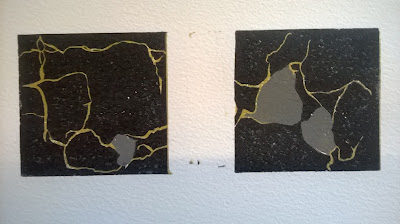The exhibition was quite a daunting experience having never exhibited outside of an educational institution, which always feels very safe. There are people there, it doesn't feel as though they're there to see (or indeed) judge your work, they've just come to support a loved one. I'm not sure if that's naive or cynical, or an odd mix of the two. Anyway, exhibiting work outside of that realm, promoting it as a 'proper' exhibition was fairly strange. Another thing I was apprehensive about was the language barrier and my inability to absorb any words other than 'caffe latte per favore?'
In spite of my worries, the exhibition proved a great success, with a fair few people wandering in from the street. One of the highlights of the show for me was Annabeth Robinson's process video, which captured everyone's working methods and showed how the work on show was created, giving a visual background on the principals behind everyone's pieces. I also made a process video, unfortunately my laptop seams to take issue with the file type, hopefully I'll be able to upload it soon.
I'm actually quite proud of the work I exhibited, creating a series of prints in three days that are show worthy is no mean feat. I originally intended them to be black and gold, but felt the addition of the grey helped to produce a more complex image whilst maintaining the overall tone of the work. I used a map of the area to produce linoprint maps coupled with prints made from tracings I took from the cracks and textures in those areas. The idea was to show how the microscape can be more descriptive of a certain place than a map, and how the small microscape and city scape are irrevocably linked. Basically how these textures can be seen as the cells from which the town is composed. The texture prints also hold a sense of time, in that they are produced by temporal processes such as weathering.
I'm actually quite proud of the work I exhibited, creating a series of prints in three days that are show worthy is no mean feat. I originally intended them to be black and gold, but felt the addition of the grey helped to produce a more complex image whilst maintaining the overall tone of the work. I used a map of the area to produce linoprint maps coupled with prints made from tracings I took from the cracks and textures in those areas. The idea was to show how the microscape can be more descriptive of a certain place than a map, and how the small microscape and city scape are irrevocably linked. Basically how these textures can be seen as the cells from which the town is composed. The texture prints also hold a sense of time, in that they are produced by temporal processes such as weathering.
And for the last time #TicTacTrento







No comments:
Post a Comment